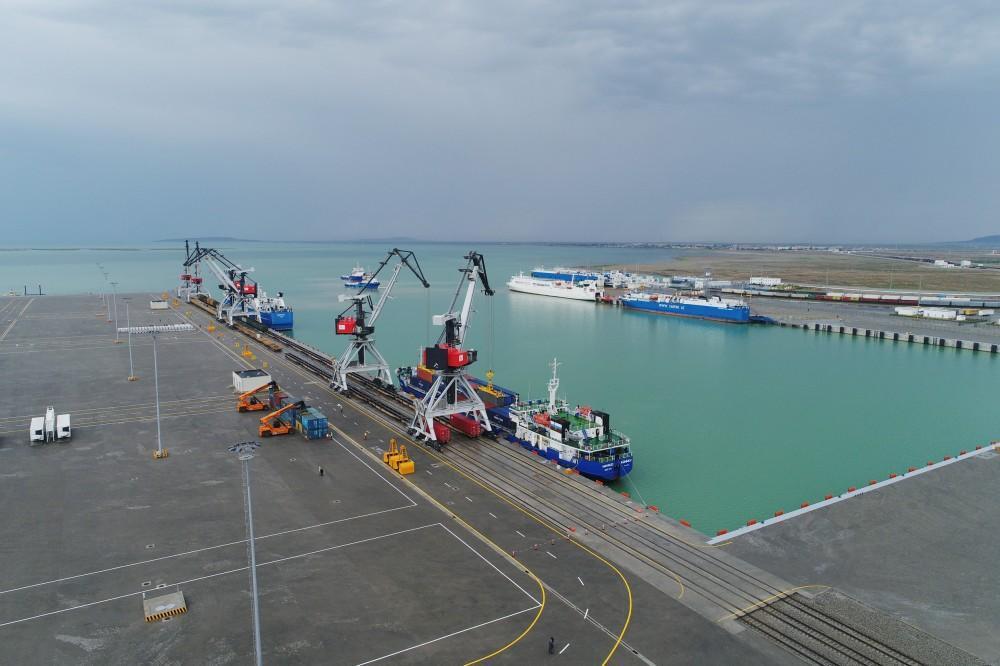Container transshipment at Baku port increases significantly

By Leman Mammadova
Due to the its geographical location, so far, Azerbaijan has enjoyed its transit and transportation opportunities by developing big infrastructure projects.
In 2018, container handling through the Baku International Sea Trade Port amounted to 20,564 TEU (twenty-foot equivalent), which is 45.3 percent more compared to the same period last year, spokeswoman of the port, Vefa Safarli-Abdullazade said on December 14.
She noted that the increase in freight traffic is also observed adding that the figure was 3.9 million tons during the period. As many as 52 percent of these goods accounted for cargo turnover with Turkmenistan.
She also underlined that the relocation of the Main Freight Terminal of "Baku International Sea Trade Port" CJSC to the new port of Baku, located in Alat settlement, will be completed in the first quarter of 2019, adding that the work on the relocation of the Baku Main Freight Terminal has already started and next year, all operations will be carried out in the new port of Alat.
The construction of the new Baku International Sea Trade Port complex started in 2010. In September 2014, the ferry terminal was commissioned, and in January 2018 - the Ro-Ro terminal. The port covers a territory of 117 hectares and has 12 berths. The total length of berths is approximately 2,100 meters.
The cargo transshipment potential of the Baku port within the first phase is 15 million tons, including 100,000 containers per year. Seven berths out of 12 existing ones serve dry-cargo ships, two berths serve ferries, and another two berths serve the Ro-Ro and Ro-Pax vessels. Another berth is used to service the flotilla of the port.
A passenger terminal is also envisaged to be constructed at the port and after its launch, the port will be able to serve 150,000 passengers.
In 2017, the volume of freight traffic through the Baku International Sea Trade Port (excluding the oil terminal) rose by 31 percent and totaled 4.4 million tons as compared to 2016. About 85.7 percent of the total volume accounted for the share of transit cargo transportation.
Touching upon the passenger transportation the spokeswoman said that since the beginning of 2018, the volume of passenger traffic through the Baku International Sea Trade Port amounted to 45,000, which is 50 percent more than in the same period of last year. This is a record figure for maritime passenger traffic in Azerbaijan over the past 20 years.
Safarli-Abdullazade added that it is expected that by the end of this year 47,000 passengers will enjoy the services of the Baku port.
She emphasized that it is also planned to start online ticket sales in 2019 aimed at increasing the passenger traffic, as well as generally simplify the process of selling tickets.
The Baku International Sea Trade Port in Azerbaijan’s Alat settlement is expected to become one of the leading trade and logistics hubs of Eurasia. The implementation of all 3 phases of construction is projected to increase the capacity up to 7,660 tons on a daily basis.
Once the first phase ends, the Baku International Sea Trade Port will be able to receive up to 10-11 million tons of cargo and process 50,000 containers per year.
The second stage will provide for the handling of 17 million tons of freight and 150,000 of containers, while the implementation of the final stage is projected to increase the capacity up to 25 million tons of freight and 1 million of containers.
The new Port of Baku is located on an area of 400 hectares (ha) of land, of which about 100-115 ha cover the area for the development of the international Logistics and Free Trade Zone (FTZ). The northern areas around the port are reserved for future expansion of logistics, industrial, and manufacturing activity.
The FTZ is expected to bring up to $1 billion just in the first few years. Special tax and customs policy, which will be pursued in the territory of the free trade zone will also stipulate further development and simplification of a number of procedures.
FTZ will be located within the grounds of the new port, covering an area of 100 hectares. Since the new port is being built at the major railway juncture connecting the North-South and the East-West railway lines in Azerbaijan, FTZ will also have rail access. Serving as a multimodal transit logistics hub, the new port and FTZ will become a major consolidation and distribution centre in Central Eurasia that provides a wide range of value added services.
---
Follow us on Twitter @AzerNewsAz
Here we are to serve you with news right now. It does not cost much, but worth your attention.
Choose to support open, independent, quality journalism and subscribe on a monthly basis.
By subscribing to our online newspaper, you can have full digital access to all news, analysis, and much more.
You can also follow AzerNEWS on Twitter @AzerNewsAz or Facebook @AzerNewsNewspaper
Thank you!
